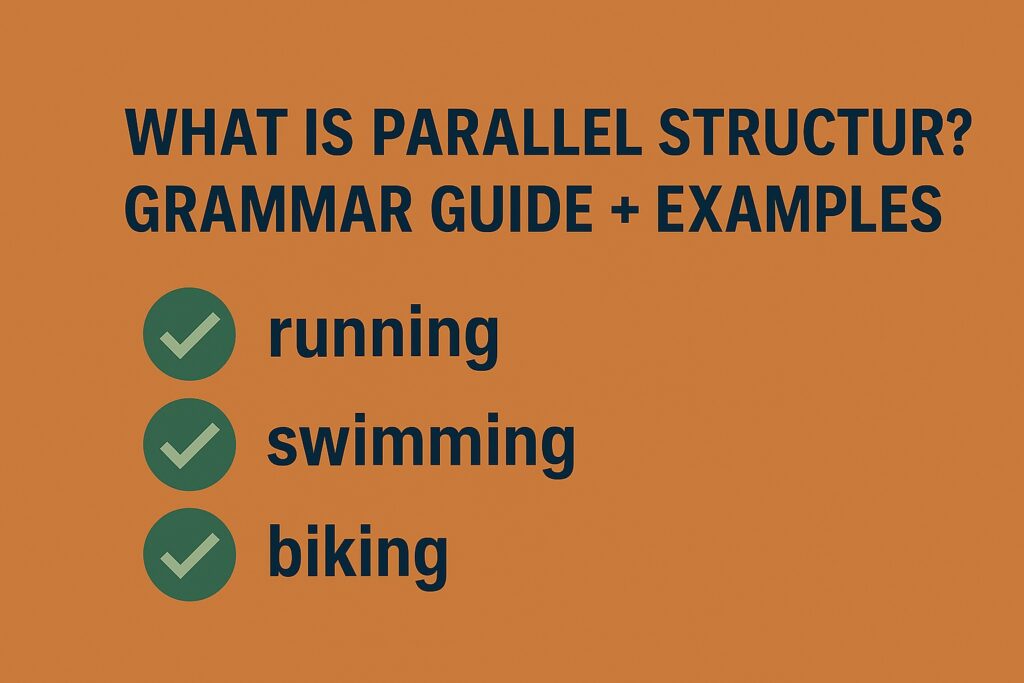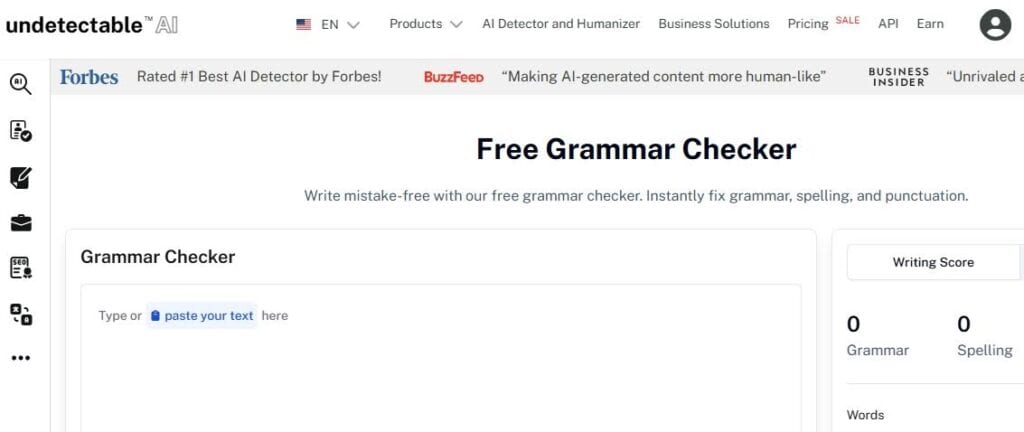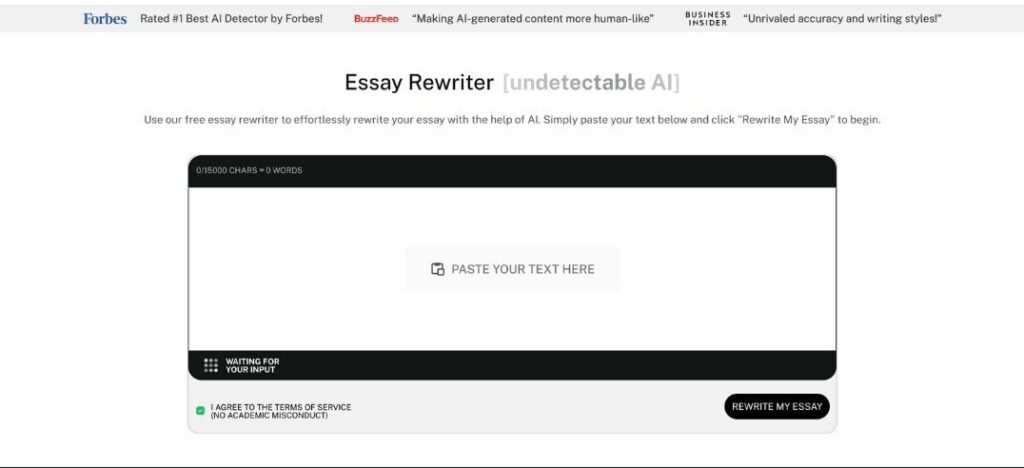I like running, to swim, and bicycles.
Read that again. It’s not wrong wrong, you still understand it, but something about it feels off, right? Like a song where one note is just… not where it should be.
That’s what happens when you break parallel structure.
Most people don’t even know they have done it. They’re writing a list, or describing a few actions, and their brain happily mixes verb forms or tosses in an odd noun.
The reader keeps going, but the sentence has already made them stumble.
Breaking a parallel structure makes your writing weak. You might not agree with me now, but once you see how it works, you’ll start spotting the problem everywhere.
Let’s get started, shall we?
Key Takeaways
- Parallel structure means keeping similar parts of a sentence in the same grammatical form so the writing flows smoothly.
- It is used in lists, comparisons, and when joining ideas with words like and or but.
- It works at the word, phrase, and clause levels, and mismatches can make sentences feel awkward.
- Watch out for common slip-ups like mixing verb forms or letting one item in a list wander off track.
- Use it to make writing clear, balanced, and easy to follow.
What Is Parallel Structure?

Parallel structure, also called parallelism, is a way of writing that keeps similar parts of a sentence in the same grammatical form.
But that’s just a textbook version of the parallel structure definition. Let me explain it using an example.
Parallel structure is like a pair of socks.


Never Worry About AI Detecting Your Texts Again. Undetectable AI Can Help You:
- Make your AI assisted writing appear human-like.
- Bypass all major AI detection tools with just one click.
- Use AI safely and confidently in school and work.
They need to be identical. If one part is a verb ending in “-ing,” the others should be too.
If you start with a noun, keep the rest as nouns. This balance makes your writing easier to read and smoother to follow.
Try reading this: She loves baking cakes, to paint, and movie nights.
You probably got the meaning, but it doesn’t sound right to the ears.
That’s because the pieces don’t match. “Baking cakes” is one style, “to paint” is another, and “movie nights” is a completely different thing altogether.
Your brain has to slow down and adjust every time the style changes.
Now, read this: She loves baking cakes, painting, and watching movies.
See the difference? Just like that, parallel structure is everywhere.
When you have a list, a series of actions, or two ideas in the same sentence, keep them in the same style.
Parallel structures can be confusing, especially if you just learned about them. But you’ve got nothing to worry about with this Ask AI tool by Undetectable AI.
It can tell if your sentence has a proper parallel construction or if it needs to be fixed.
When to Use Parallel Structure
Before you know when to use it, it helps to understand what is parallel structure. It simply means that the parts of your sentence follow the same pattern, so the rhythm feels even and the meaning is clear.
You reach for parallel structure when:
- You’re making a list.
If one item starts with an action word, the others should too. - You’re joining ideas.
When two thoughts are linked by “and,” “or,” or “but,” they should be built the same way. - You’re drawing a comparison.
The two sides of the comparison should mirror each other. - You want impact
Repeating the same structure can make an idea more memorable.
Examples of Parallel Structure

Sometimes you read a sentence and it feels like each part steps in time with the others.
Other times, one word trips, and the whole rhythm stumbles.
These parallel structure examples show both the smooth patterns and the awkward stumbles, so you can see exactly where balance is kept and where it breaks.
1. Word-Level Parallel Structure
Parallelism at the word level is the simplest form. It occurs when items in a list or series are the same type of word, such as all verbs, all nouns, or all adjectives.
It’s important because when the forms match, the reader processes them as equal and related.
Verbs:
- Correct: He cooked, cleaned, and painted.
(All three verbs are in the same tense and form.) - Incorrect: He cooked, cleaning, and painted.
(The middle verb changes form and disrupts the flow.)
Nouns:
- Correct: We need bread, milk, and butter.
- Incorrect: We need bread, milk, and to buy butter.
(Two nouns after an infinitive breaks the pattern.)
Adjectives:
- Correct: The room was quiet, warm, and comfortable.
- Incorrect: The room was quiet, warm, and comfort.
(The last item switches from an adjective to a noun.)
2. Phrase-Level Parallel Structure
Here, instead of single words, you’re dealing with phrases. The pattern still matters, but the matching has to happen in a longer structure. If the first phrase starts with “to,” for example, the rest should too.
Infinitive phrases (to + verb):
- Correct: He likes to read, to write, and to explore.
- Incorrect: He likes reading, to write, and exploring.
(The forms jump between -ing verbs and to + verb.)
Gerund phrases (-ing verbs as nouns):
- Correct: Swimming, running, and cycling are great exercises.
- Incorrect: Swimming, to run, and cycling are great exercises.
Prepositional phrases:
- Correct: She looked under the bed, behind the curtain, and inside the closet.
- Incorrect: She looked under the bed, behind the curtain, and the closet.
(The last item drops the preposition, so it no longer matches.)
3. Clause-Level Parallel Structure
Parallel structure matters even more when sentences get longer. In clauses, i.e., parts of a sentence with their own subject and verb, mismatched patterns are easier to spot because they interrupt the flow.
That-clauses:
- Correct: She believes that honesty is essential, that kindness goes a long way, and that hard work pays off.
(Each idea starts with “that” and uses the same structure.) - Incorrect: She believes that honesty is essential, kindness goes a long way, and that hard work pays off.
(The middle clause drops “that,” so the rhythm breaks.)
Dependent clauses:
- Correct: I left because it was late, because I was tired, and because I had an early meeting.
- Incorrect: I left because it was late, I was tired, and because I had an early meeting.
4. Side-by-Side Parallelism in Action
Sometimes, a single sentence can change with and without parallel structure:
- Incorrect: She enjoys hiking, to swim, and biking.
- Correct: She enjoys hiking, swimming, and biking.
The meaning is the same, but the second one is easier to read. The three -ing forms line up, and that makes the sentence feel smooth and deliberate.
Parallel structure isn’t about making sentences pretty for grammar’s sake. It’s for making your meaning easier to absorb.
When forms match, the reader doesn’t have to work to figure out how the parts connect.
Make it a habit to run your sentences through this Grammar Checker by Undetectable AI. It can detect parallel structure errors right away and tell you how to fix them, too.

Parallel Structure in Formal Writing
In formal writing, i.e., essays, reports, or official letters, parallel structure makes your sentences feel steady and intentional.
When the parts match, the reader can follow your point without getting stuck. When they don’t, the sentence can feel awkward, even if the meaning is clear.
In longer, more formal and complex sentences, it’s easy to lose this balance without noticing. You might change a word or two while editing and end up with a mix of forms.
But that’s okay as long as you’re using this AI Humanizer by Undetectable AI.
You just paste in your sentence, and it will smooth it out while ensuring it sounds natural.
Common Mistakes and How to Fix Them
Even when you understand parallel structure, it’s easy to slip up. It mostly happens when you’re writing or editing in a hurry.
Here are some of the most common problems, with a parallel structure example for each one.
1. Mixing Verb Forms
When items in a list don’t follow the same verb pattern, the sentence feels uneven.
- Wrong: He likes to run, walking in the park, and jog with friends.
- Right: He likes to run, walk in the park, and jog with friends.
2. Unbalanced Lists or Clauses
If your list mixes different types of items, the reader has to work harder to connect them.
- Wrong: The project requires planning, communication, and that we meet deadlines.
- Right: The project requires planning, communicating, and meeting deadlines.
3. Breaking Structure After “and” or “but”
When two ideas are joined with “and” or “but,” they should match in form.
- Wrong: The plan is ambitious but taking too long to start.
- Right: The plan is ambitious but slow to start.
4. Redundant Constructions
Sometimes sentences repeat the same meaning in slightly different forms, which makes them clunky.
- Wrong: She decided to make a decision to leave the company.
- Right: She decided to leave the company.
When you’re fixing these issues in long-form content, you may want to take help from Undetectable AI’s Essay Rewriter.
It can restructure whole paragraphs, improve the logical flow, and make sure your parallel structure stays consistent from sentence to sentence.

Style and Emphasis with Parallelism
Sure, following parallel construction is part of the grammar rules. However, it’s also a way to make your writing sound more deliberate and powerful.
1. Using Repetition for Impact
Repeating the same structure can make a message clearer and more persuasive.
We want justice. We want fairness. We want change.
The sentence is not exactly correct, but it works because each part has the same rhythm. The reader starts to expect the pattern. That makes the message sink in.
2. Parallel Structure in Speeches and Persuasive Writing
Many well-known speeches use parallelism to build momentum and keep the audience engaged.
- Martin Luther King Jr.: “I have a dream…” repeated to show a vision in different ways.
- Winston Churchill: “We shall fight on the beaches, we shall fight on the landing grounds…” keeping the pace steady while the content builds in strength.
The repeated structure makes the listener feel the ideas are part of one unified thought.
3. Breaking the Pattern on Purpose
If everything is perfectly balanced, it can feel predictable. Changing the pattern at the right moment can draw attention to one key point.
She came to listen, to learn, to understand…and to challenge.
The first three actions are parallel. The last one breaks the pattern slightly, which makes it stand out.
Take a moment to explore our AI Detector and Humanizer in the widget below!
Final Thoughts
Whoever said words don’t matter clearly never met parallel structure. It’s the difference between a sentence that marches forward in step and one that limps to the finish.
When you match your forms and keep your rhythm, your writing automatically feels more confident and persuasive.
Like I said, it can be a hard catch. But once you start noticing it, you can’t unsee it (and neither can your audience).
With Undetectable AI’s AI Essay Rewriter and Grammar Checker, you can quickly identify and fix parallel structure issues for smoother, more compelling writing.
Get better at forming parallel structure in your sentences using Undetectable AI.
